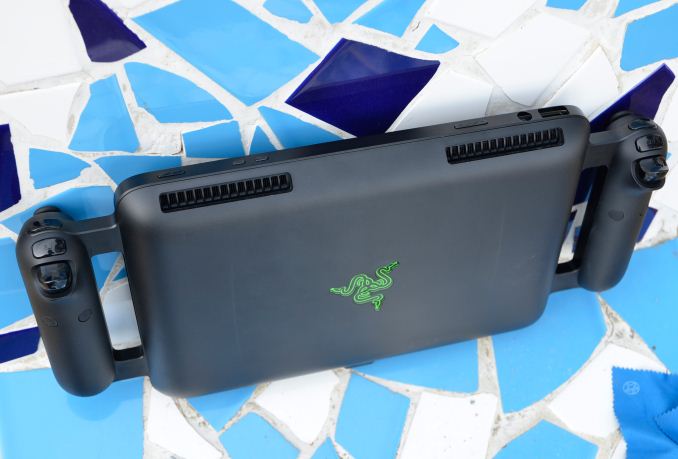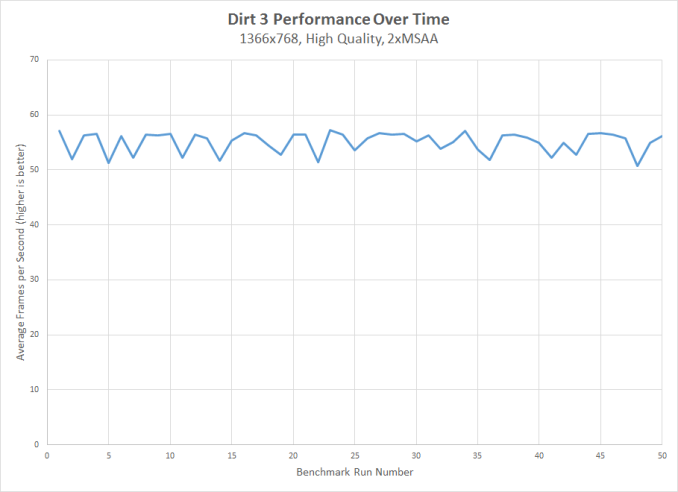The Razer Edge Review
by Vivek Gowri on March 28, 2013 11:00 AM EST- Posted in
- Tablets
- Mobile
- Razer
- Razer Edge
Thermals
The thermal story here is pretty interesting. Obviously, with a huge thermal envelope for such a small form factor, the first concern I had was for heat. Razer has a fair bit of experience shoving a lot of hardware in tight spaces, though with the Blade the problem construction was different. The Blade chassis is very thin, but has a lot of room in terms of footprint. The sheer amount of surface area top and bottom, as well as all the venting on the bottom and sides, help the Blade (especially the 2nd generation one) effectively cool itself even though there’s relatively little volume available.
The Edge, by comparison, has a tiny footprint and hence needs to be much thicker than competing tablets; it’s actually also thicker than the bottom casing of the Blade, so there’s that too. Airflow is extremely key here, since there’s very little surface area to let heat dissipate convectively. The heat pipe, too, is key, as tablets have far more orientations that need to be designed for when compared to notebooks. Orientation matters for heat pipes, as their effectiveness depends on how much working fluid can be transported from the condenser to the evaporator. Operating against gravity is always a losing proposition, and as such there’s an inverse correlation between transport capacity and operation against gravity (ie, as the angle of operation against gravity increases, the transport capacity of the heat pipes typically decrease.)
At some point in the future I’ll do a much more thorough article on how heat pipes and the cooling systems in mobile computers work, but for now this will have to suffice. The TL;DR version as pertinent to this article: if you have enough compute horsepower in a tablet to require active cooling, you’re in for a hell of a time. Tablets are much harder to cool actively than notebooks.
Which is why thermal performance was, for me at least, the major concern with the Edge prior to launch. The 0.8” thickness helped alleviate my fears somewhat, because that gets you a significant amount of volume to work with compared to something like the Surface Pro. Ivy Bridge ULV and Kepler are also pretty good as far as thermal performance goes, so I wasn’t concerned at all about how it would behave under light usage cases, particularly ones that didn’t have the GPU turning on. But when the system is stressed, what then?
To find out, I fired up my 100% system load test – Furmark 1080p and wPrime 1024M (4 threads) looping, which maxes CPU and GPU – and let it run for a sustained period of time. I saw GPU temps hit 85C with ease, while CPU got up to 95C. The GPU temperature stabilizes in the 87F region at 0.887V (the voltage at 500MHz). CPU temp stabilizes in the low 90s, which is interesting because we typically see CPU temperatures that are lower than the GPU temps. CPU power draw hovers around 14.7W when both cores are loaded. The Edge reaches thermal equilibrium before it starts throttling the GPU, which is a good sign.
I also ran my real-world gaming situation with the Dirt 3 benchmark, and like last time, ran it 50 times in a row, this time on high settings with 2xMSAA at 1366x768, my graphics setup of choice for playing the game when the Edge was plugged in. The results were pretty interesting – while average framerates stayed in the 52-56 fps range for a majority of the tests, the minimum framerate told a good bit of the story. There are three primary speeds and voltages the GPU runs at: the default 500MHz (0.887V), 570MHz (0.912V), and 405MHz (0.813V). In many of the runs in the 55-57fps range, the minimum framerate would be around 45-46fps, while some of the runs that had average fps on the low end (51-52fps), the minimum framerate would be below 40, sometimes as low as 35 fps. This happened every three or four runs, with consistency, with the GPU clocking down to the lower voltage performance state when necessary in order to maintain thermal equilibrium. At no point was there an extended period of throttling, which is why performance remained mostly constant for the roughly two and a half hours it took to go through 50 runs of the benchmark. That’s pretty impressive, considering the amount of thermal stress the GPU puts on a system of this size.












89 Comments
View All Comments
VivekGowri - Friday, March 29, 2013 - link
All of the battery life tests (in the graphs) were done with the internal 41Wh battery, with the tablet alone - not attached to the gamepad or the docking station. 5 hours of light web-usage is for the tablet alone, no extended batteries involved.The gaming tests were the only ones done with the extended battery and gamepad controller (which I think have to be bought together for the package to make any sense). I do wish that the gamepad came with the extended battery by default, Razer is definitely charging too much for the accessories.
TrackSmart - Friday, March 29, 2013 - link
I think the review does a fine job of giving us a sense of the product. The one change I would make is to emphasize the battery issue in the Conclusions in a more concrete way:For example: "You can only expect around 1 hour of gaming time using the built-in 41 Wh battery and just over 2 hours with the gaming dock plus extra battery pack ($XXX extra). For a system that promises PC-quality gaming on the road, this may be a fatal flaw."
That's the point that really needs to be driven home. This is an impressive system, but the components available today do not have the power efficiency needed to make a truly portable system at this level of performance.
apertotes - Thursday, March 28, 2013 - link
Yeah, the second generation is going to be awesome... whatever. I will wait until that awesome product. And I guess many people will do the same. You can not pretend to sell a hardware product on the assumption that the next one is going to be great. This Razer Edge lacks in graphic power and battery life. This one. The one that is now for sale. That sucks.nerd1 - Thursday, March 28, 2013 - link
All razor so-called gaming PCs are big joke, I wonder what they are thinking. I'd rather get a clevo 11.6" with 650M on this.VivekGowri - Thursday, March 28, 2013 - link
I had that system, and I loved the hell out of it. GT 650M is overkill for the 1366x768 panel, FWIW. But the Edge is truly, completely different. It's just a different system in almost every way, there's no real comparison between the two other than on a benchmark sheet.nerd1 - Thursday, March 28, 2013 - link
So I just cannot understand why they chose a tablet form factor. W8 doesn't have many games with touch control (I hate touch control for gaming BTW) so you need keyboard and (good) mouse anyway. And it is not quite portable and very expensive.VivekGowri - Thursday, March 28, 2013 - link
when one sets out to make a gaming tablet, choosing a tablet form factor would in theory seem logical, no?kyuu - Thursday, March 28, 2013 - link
That's what the shell with the gamepad controls is for...?A5 - Thursday, March 28, 2013 - link
Just because you don't like something doesn't mean it is pointless.bountygiver - Thursday, March 28, 2013 - link
But hope some games can add touch control where appropriate. (Like civ 5)